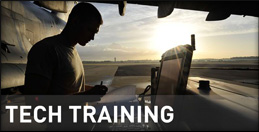Missions Part Two: Air Power Comes of Age in World War II
After September 1939, when Adolf Hitler launched World War II by invading Poland, the Air Corps began a steady growth from 26,000 personnel and fewer than 2,000 planes. On June 20, 1941, the Department of War created the Army Air Forces (AAF) as its aviation element and shortly thereafter made it coequal to the Army Ground Forces. The Air Corps remained as one of the Army's combat arms, like the infantry.
Expansion of the AAF accelerated after the surprise Japanese attack on Hawaii in December 1941 propelled the United States into the war. Under the leadership of Gen. Henry H. ("Hap") Arnold, the Army Air Forces oversaw mobilization of the nation's aviation industry and deployment of the largest air armada of all time. The AAF's inventory encompassed a wide range of training, transport, pursuit, attack, reconnaissance and bomber aircraft. These included the ubiquitous C-47 Skytrain, the splendid P-51 Mustang, the rugged B-17 Flying Fortress and the awesome B-29 Superfortress. Drawing upon American industrial prowess and human resources, the AAF reached a peak strength of 80,000 aircraft and 2.4 million personnel organized into major commands, numbered air forces, air divisions, groups and squadrons. AAF units conducted a wide range of air operations over every theater of battle from the jungle-clad islands of the Southwest Pacific to the sun-baked deserts of Northern Africa, from the icy waters of the North Atlantic to the snow-capped peaks of the Himalayas.
By the last year of the war, the quantity and quality of elite AAF units, such as the Tuskegee Airmen, dominated the skies over both Germany and Japan, all but paralyzing their war economies. Air power did not win the war by itself but did make possible the Allies' total victory over the Axis powers, punctuated in August 1945 when two B-29s dropped atomic bombs on Japan.
Much as it did a quarter century before, the United States immediately demobilized its armed forces after World War II. Based on the AAF's wartime achievements and future potential, however, the U.S. Air Force won its independence as a full partner with the Army and the Navy on September 18, 1947. Stuart Symington became the first Secretary of the Air Force, and Gen. Carl A. Spaatz its first Chief of Staff. Within a month, on October 14, 1947, test pilot Chuck Yeager flew the Bell XS-1 past the speed of sound, launching the new Air Force into the supersonic era.

